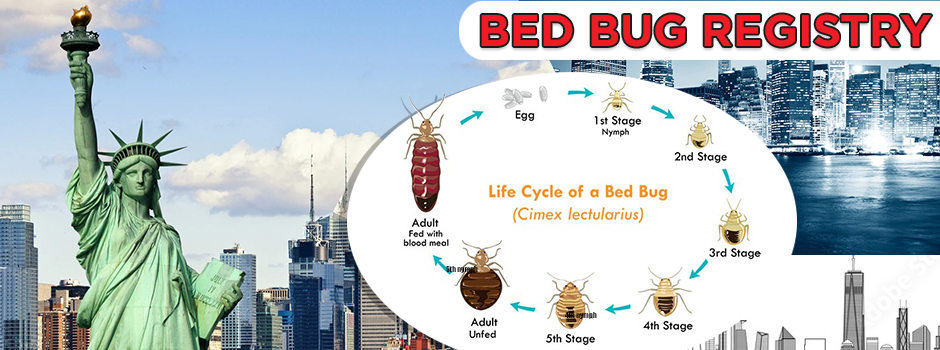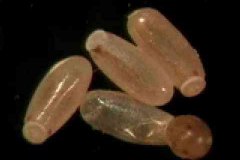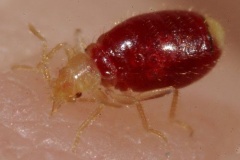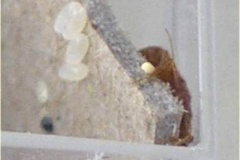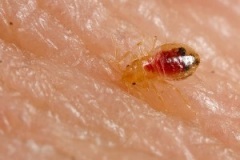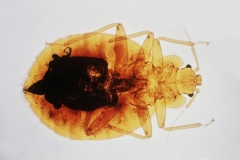Bed bug species
 Bed bugs are remarkable examples of evolution in action. Some species are in evolutionary stasis, but the bed bug is active and never static, this process of constant change and adaptation being a requirement if a bug is going to survive by targeting a human being.
Bed bugs are remarkable examples of evolution in action. Some species are in evolutionary stasis, but the bed bug is active and never static, this process of constant change and adaptation being a requirement if a bug is going to survive by targeting a human being.
It has occurred to me that every attempt to force bed bugs into extinction has failed, since such violent tactics contradict the interests of the bed bug, since bed bugs are driven by a powerful instinct to survive. For this reason I have come up with an idea which would involve eliciting the cooperation of bed bugs rather than inspiring the resistance of bed bugs, which is all we ever accomplish with chemical spraying.
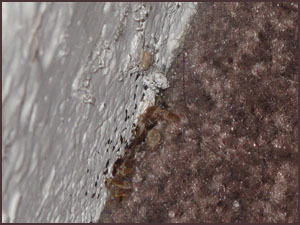 When bed bugs are raised in laboratories they are kept alive by feeding them through the use of membranes containing either pig or chicken blood. Since bed bugs were once sap suckers instead of blood suckers like they are now, it has occurred to me that given how evolutionary active this species, it would be an interesting experiment in living evolution to begin the process of weaning bed bugs off of human blood and back onto plant sap. For you see, bed bugs are just bugs and they are currently trapped in an endless cycle of battling with some unwilling human host for the blood they now require if their species is to survive. Since a human being is the partner of that bug in this symbiotic relationship, and since it is the human who has all the brains in that symbiotic relationship, it should be possible for the human being to use those brains to train bed bugs to find a new food source, and thus bring the battle between bed bugs and human beings to a permanent end, by '˜exterminating' the bed bug species by weaning them off of human blood.
When bed bugs are raised in laboratories they are kept alive by feeding them through the use of membranes containing either pig or chicken blood. Since bed bugs were once sap suckers instead of blood suckers like they are now, it has occurred to me that given how evolutionary active this species, it would be an interesting experiment in living evolution to begin the process of weaning bed bugs off of human blood and back onto plant sap. For you see, bed bugs are just bugs and they are currently trapped in an endless cycle of battling with some unwilling human host for the blood they now require if their species is to survive. Since a human being is the partner of that bug in this symbiotic relationship, and since it is the human who has all the brains in that symbiotic relationship, it should be possible for the human being to use those brains to train bed bugs to find a new food source, and thus bring the battle between bed bugs and human beings to a permanent end, by '˜exterminating' the bed bug species by weaning them off of human blood.
 My proposal for such an experiment would involve diluting the blood contained in feeding membranes with a small amount of sap from plants. With each generation of bed bugs produced, the amount of sap would be increased and the amount of blood gradually reduced. Since bed bugs are such adaptable creatures, given enough time, and enough generations of bed bugs, I would expect their to emerge at the end of the experiment a strain of '˜plant bugs' which is where bed bugs first began their evolutionary journey, and where they must return.
My proposal for such an experiment would involve diluting the blood contained in feeding membranes with a small amount of sap from plants. With each generation of bed bugs produced, the amount of sap would be increased and the amount of blood gradually reduced. Since bed bugs are such adaptable creatures, given enough time, and enough generations of bed bugs, I would expect their to emerge at the end of the experiment a strain of '˜plant bugs' which is where bed bugs first began their evolutionary journey, and where they must return.
Such an approach has never been attempted, and if I had the money to fund the experiment myself, I would begin today, because I am convinced this approach would work, and it is certainly worth making an attempt.
Some bed bug species are parasites of bats or birds, and may bite people if the wild hosts are no longer available. If bat bugs or bird bugs are involved, roosting and nesting sites should be the primary focus of treatment and the animals excluded from the building. The common bed bug, Cimex lectularius, is the species most adapted to living with humans. It has done so since ancient times. Bed bugs are mentioned in medieval European texts and in classical Greek writings back to the time of Aristotle. Other bed bug species prefer to feed on wild hosts, especially bats and birds.
AC_AX_RunContent( 'width','494','height','394','align','left','style','margin-right:3px;','src','https://www.youtube.com/v/YgZ9mAxAke0&hl=en_US&fs=1&','type','application/x-shockwave-flash','allowscriptaccess','always','allowfullscreen','true','movie','https://www.youtube.com/v/YgZ9mAxAke0&hl=en_US&fs=1&' ); //end AC code All of these species are generally similar in appearance. They are reddish-brown to grayish-brown with an oval body form and about 3/8-in long when full-grown. All are wingless, although small wing pads are present on the back. Their body is flattened when unfed, although they swell rapidly with a blood meal.
 When bedbugs are raised in laboratories they are kept alive by feeding them through the use of membranes containing either pig or chicken blood. Since bedbugs were once sap suckers instead of blood suckers like they are now, it has occurred to me that given how evolutionary active this species, it would be an interesting experiment in living evolution to begin the process
When bedbugs are raised in laboratories they are kept alive by feeding them through the use of membranes containing either pig or chicken blood. Since bedbugs were once sap suckers instead of blood suckers like they are now, it has occurred to me that given how evolutionary active this species, it would be an interesting experiment in living evolution to begin the process  of weaning bedbugs off of human blood and back onto plant sap. For you see, bedbugs are just bugs and they are currently trapped in an endless cycle of battling with some unwilling human host for the blood they now require if their species is to survive. Since a human being is the partner of that bug in this symbiotic relationship, and since it is the human who has all the brains in that symbiotic relationship, it should be possible for the human being to use those brains to train bedbugs to find a new food source, and thus bring the battle between bedbugs and human beings to a permanent end, by '˜exterminating' the bedbug species by weaning them off of human blood.
of weaning bedbugs off of human blood and back onto plant sap. For you see, bedbugs are just bugs and they are currently trapped in an endless cycle of battling with some unwilling human host for the blood they now require if their species is to survive. Since a human being is the partner of that bug in this symbiotic relationship, and since it is the human who has all the brains in that symbiotic relationship, it should be possible for the human being to use those brains to train bedbugs to find a new food source, and thus bring the battle between bedbugs and human beings to a permanent end, by '˜exterminating' the bedbug species by weaning them off of human blood.
 The mouthparts of bed bugs are especially adapted for piercing skin and sucking blood. Like most blood sucking arthropods, they inject saliva during feeding, which has anticoagulant properties. Bed bugs respond to the warmth and carbon dioxide of a host and quickly locate a suitable feeding site. They tend not to live on humans and the only contact is for a blood meal. Most blood feeding occurs at night, and they generally seek shelter during the day and become inactive while digesting the blood meal. However, bed bugs are opportunistic and will bite in the day especially if starved for some time. They can survive for long periods without feeding. While their preferred host is human, they will feed on wide variety of other warm-blooded animals including rodents, rabbits, bats, and even birds.
The mouthparts of bed bugs are especially adapted for piercing skin and sucking blood. Like most blood sucking arthropods, they inject saliva during feeding, which has anticoagulant properties. Bed bugs respond to the warmth and carbon dioxide of a host and quickly locate a suitable feeding site. They tend not to live on humans and the only contact is for a blood meal. Most blood feeding occurs at night, and they generally seek shelter during the day and become inactive while digesting the blood meal. However, bed bugs are opportunistic and will bite in the day especially if starved for some time. They can survive for long periods without feeding. While their preferred host is human, they will feed on wide variety of other warm-blooded animals including rodents, rabbits, bats, and even birds.
Being a cryptic species, bed bugs shelter in a variety of dark locations, mostly close to where people sleep. These include under mattresses, floorboards, paintings and carpets, behind skirting, in various cracks and crevices of walls, within bed frames and other furniture, and behind loose wallpaper. Bed bugs tend to stay in close contact with each other and heavy infestations are accompanied by a distinctive sweet sickly smell. Blood spotting on mattresses and nearby furnishings is often a tell tale sign of an infestation.

 Residence
Residence  Location
Location 

 For those who have experienced the itchy bites from a bed bug infestation, killing bed bugs effectively is the top priority for choosing a pest control method. According to scientific reports, cases of bed bugs are increasing at rates staggering rates each year. These parasites feed on people and animals and are finding their way in our hotels and homes by riding in suitcases and on the clothing of travelers from other countries. In order to rid a home or business from an infestation strict procedures are required and this is why professionals recommend the non toxic Bed Bugs Patrol System. Bed Bug Patrol is one of the most effective bed bugs repellant products on the market. It is 100% natural and contains no bed bug pesticides. This makes non toxic Bed Bugs Patrol safe to use around children and pets. It is easy to use and environmentally friendly. It is a truly the Green way to wipe out a bed bug infestation and kills adults, larvae and eggs. Spray all surfaces with non toxic Bed Bugs Patrol for immediate kill.
For those who have experienced the itchy bites from a bed bug infestation, killing bed bugs effectively is the top priority for choosing a pest control method. According to scientific reports, cases of bed bugs are increasing at rates staggering rates each year. These parasites feed on people and animals and are finding their way in our hotels and homes by riding in suitcases and on the clothing of travelers from other countries. In order to rid a home or business from an infestation strict procedures are required and this is why professionals recommend the non toxic Bed Bugs Patrol System. Bed Bug Patrol is one of the most effective bed bugs repellant products on the market. It is 100% natural and contains no bed bug pesticides. This makes non toxic Bed Bugs Patrol safe to use around children and pets. It is easy to use and environmentally friendly. It is a truly the Green way to wipe out a bed bug infestation and kills adults, larvae and eggs. Spray all surfaces with non toxic Bed Bugs Patrol for immediate kill.  Bed Bug repellant sprays kill on contact while the Fossil Shell Dust provides long-term protection. This natural and non-toxic product can be used over long periods of time to prevent bed bugs from reoccurring. This bed bugs repellant product is made up of crushed fossils shells of freshwater organisms and marine life. It is a fine powder that is harmful to all insects. It penetrates their shell and dehydrates the pest killing it. For a full list of instructions on how to remove a home or office of a bed bug infestation visit
Bed Bug repellant sprays kill on contact while the Fossil Shell Dust provides long-term protection. This natural and non-toxic product can be used over long periods of time to prevent bed bugs from reoccurring. This bed bugs repellant product is made up of crushed fossils shells of freshwater organisms and marine life. It is a fine powder that is harmful to all insects. It penetrates their shell and dehydrates the pest killing it. For a full list of instructions on how to remove a home or office of a bed bug infestation visit  EcoBugFree is an effective, environmentally friendly, non-toxic treatment that exterminates bed bugs without the use of pesticides. An EPA-exempt product classified as a minimal risk pesticide, the EcoBugFree formula uses natural minerals and non-toxic compounds to control bed bug infestations without compromising the safety and quality of your sleeping environment. It's safe for pets, easy to use and guaranteed to work! Studies show a 97% kill rate forbed bugsafter just one spray, compared to other common pesticides on the market today, with less than a 50% kill rate after 10 days of use.
EcoBugFree is an effective, environmentally friendly, non-toxic treatment that exterminates bed bugs without the use of pesticides. An EPA-exempt product classified as a minimal risk pesticide, the EcoBugFree formula uses natural minerals and non-toxic compounds to control bed bug infestations without compromising the safety and quality of your sleeping environment. It's safe for pets, easy to use and guaranteed to work! Studies show a 97% kill rate forbed bugsafter just one spray, compared to other common pesticides on the market today, with less than a 50% kill rate after 10 days of use. 

 A detection dog or sniffer dog is a dog that is trained to and works at using its senses (almost always the sense of smell) to detect substances such as explosives, illegal drugs, or blood. Bed Bug sniffing dogs are trained to work for food and love, not profits. Bed Bug detecting canines can 'œsweep' a standard hotel room in 2-3 minutes with pin-point accuracy. A dog's 'œodor image' is significantly more complex than a human's perception of photographs. For example, from a single drop of urine one canine can identify another K-9's sex, diet, health and even determine whether this dog is dominant or submissive! Dog's can easily distinguish between ten different odor types. They have been employed successfully to detect mold, termites, drugs and arson components. Use of Bed Bug detecting canines has been acknowledged in the court system as an effective tool. Bed Bug dogs are accurate over 90% of the time and identify Bed Bug harborage in walls, under floors and other inaccessible areas. Humans are traditionally limited to visual inspections rearing accurate results 30% of the time. Humans can take up to 20 minutes per room performing visual examinations! Not good.
A detection dog or sniffer dog is a dog that is trained to and works at using its senses (almost always the sense of smell) to detect substances such as explosives, illegal drugs, or blood. Bed Bug sniffing dogs are trained to work for food and love, not profits. Bed Bug detecting canines can 'œsweep' a standard hotel room in 2-3 minutes with pin-point accuracy. A dog's 'œodor image' is significantly more complex than a human's perception of photographs. For example, from a single drop of urine one canine can identify another K-9's sex, diet, health and even determine whether this dog is dominant or submissive! Dog's can easily distinguish between ten different odor types. They have been employed successfully to detect mold, termites, drugs and arson components. Use of Bed Bug detecting canines has been acknowledged in the court system as an effective tool. Bed Bug dogs are accurate over 90% of the time and identify Bed Bug harborage in walls, under floors and other inaccessible areas. Humans are traditionally limited to visual inspections rearing accurate results 30% of the time. Humans can take up to 20 minutes per room performing visual examinations! Not good.  A trained professional inspector will only detect visible signs of bed bugs in a room with an accuracy rate of only about 30%. To find activity inside walls, baseboards, even under carpets, a room would have to otherwise be stripped down beyond the bare walls! Due to a dog's keen sense of smell, our trained dog Tracker can detect bed bugs even inside walls - with 90% accuracy, making his inspection a more thorough and accurate one. A more accurate detection means that if there is bed bug activity, Tracker will be alert to it and control measures can begin.
A trained professional inspector will only detect visible signs of bed bugs in a room with an accuracy rate of only about 30%. To find activity inside walls, baseboards, even under carpets, a room would have to otherwise be stripped down beyond the bare walls! Due to a dog's keen sense of smell, our trained dog Tracker can detect bed bugs even inside walls - with 90% accuracy, making his inspection a more thorough and accurate one. A more accurate detection means that if there is bed bug activity, Tracker will be alert to it and control measures can begin. There are around 100 working bed bug dogs in the U.S. today, according to Greg Baumann, senior scientist at the National Pest Management Association. More are likely on the way. The Florida-based J & K Canine Academy has trained 60 dogs to detect bed bugs over the past three years and currently has a waiting list.
There are around 100 working bed bug dogs in the U.S. today, according to Greg Baumann, senior scientist at the National Pest Management Association. More are likely on the way. The Florida-based J & K Canine Academy has trained 60 dogs to detect bed bugs over the past three years and currently has a waiting list.